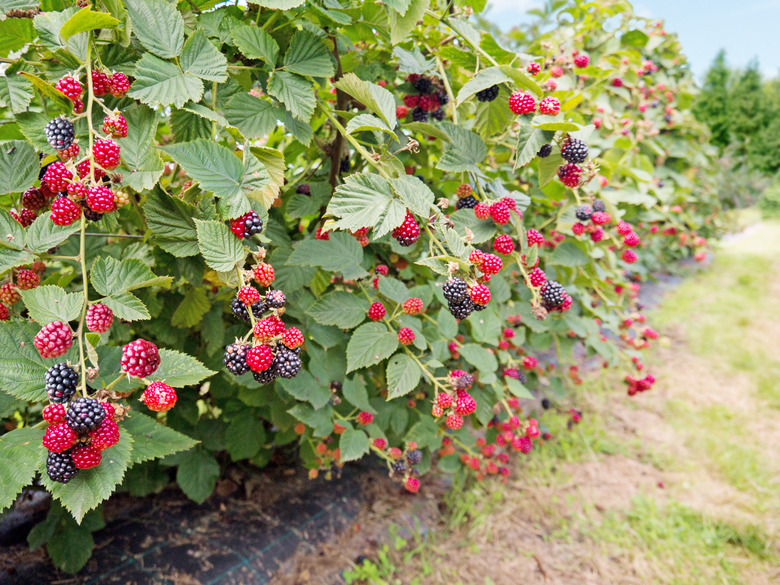Care & Maintenance Of Blackberry Bushes
With proper care and maintenance, blackberry bushes (Rubus spp.) can produce a steady harvest each summer for decades. These berries can be grown throughout much of the United States, and your local nursery or garden center should be able to offer guidance about the best cultivars for your area.
There are three types of blackberry plants. Erect plants grow fruit on canes that support themselves. Semi-erect and trailing plants require support for the fruit-bearing canes, such as a blackberry bush trellis. Growing blackberries on a fence is a way to turn utilitarian fencing into a vertical green growing space.
Blackberry Site Selection
Although full sun is best, blackberries can also tolerate partial shade. Avoid spots that are prone to high winds. And don't plant your blackberries where strawberries, cane berries, tomatoes, peppers and potatoes have been grown in the past three years. This increases the chance of your bushes becoming diseased or infested with insect pests.
Blackberry Soil Needs
Blackberries need a rich, well-draining soil. If the soil is too wet, your blackberry plants may die. If your soil does not drain well, consider adding amendments such as mulch or compost to absorb some excess moisture, or build a raised bed for your bushes. Optimal soil pH for blackberries is between 6 and 6.5.
Spring Care for Blackberry Bushes
Blackberry bushes should be planted in early spring, as soon as the soil is warm enough to be easily worked. Before planting, remove all weeds and other vegetation from the area. Each bush should be planted in a shallow hole that is deep enough and wide enough to accommodate the entire root structure.
If you are planting several bushes, space them 4 feet to 10 feet apart for trailing varieties and 4 feet to 6 feet apart for erect varieties. Rows should be 8 feet to 10 feet apart for both trailing and erect bushes.
Blackberry Pruning Tips
Traditional blackberry bushes grow biennial canes. Primocanes, the first-year canes, do not produce fruit, while floricanes, the second-year canes, grow the berries. But there are some primocane-fruiting blackberry cultivars that do produce fruit the first year. The North Carolina State Extension lists Prime-Ark Freedom and Prime-Ark 45 as thornless primocane-fruiting cultivars.
The canes on blackberry bushes should be pruned immediately after planting if it was not done prior to purchase. After planting, cut back the canes to 6 inches in length. After initial pruning, blackberry bushes require regular but minimal pruning. For erect bushes, trim 1 or 2 inches off the primocanes once they are 3 feet tall.
Floricanes should be removed after harvest is complete. In the winter, prune your bushes so there are only three or four primocanes. With trailing blackberry plants, floricanes should be removed once you are done harvesting the fruit. Some of the primocanes should also be removed, so there are only between six to 12 per plant.
Fertilizing and Harvesting Blackberries
Apply fertilizer in early spring when you begin to notice new growth. The University of California recommends using 1 pound of 20-20-20 fertilizer for each 25 feet of row.
Blackberries will not produce fruit in the first year after planting unless they're a primocane-fruiting cultivar. In the second year, you will likely start getting a small harvest. Expect a first full harvest between three and five years after planting. Once your bushes are bearing fruit, the ripe berries should be picked every three to six days. It's best to pick berries in the morning, before the heat of the day sets in. Once picked, blackberries can be stored in the refrigerator for a few days.
